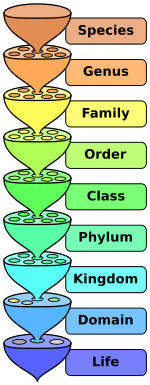Difference between revisions of "Species"
From Coastal Wiki
Astamoulis (talk | contribs) |
Dronkers J (talk | contribs) |
||
| (4 intermediate revisions by 2 users not shown) | |||
| Line 1: | Line 1: | ||
| + | |||
[[Image:150px-Biological_classification_L_Pengo.svg.png|right|The hierarchy of biological classification's major eight taxonomic ranks. A genus contains one or more species. Intermediate minor rankings are not shown. | [[Image:150px-Biological_classification_L_Pengo.svg.png|right|The hierarchy of biological classification's major eight taxonomic ranks. A genus contains one or more species. Intermediate minor rankings are not shown. | ||
<ref>http://en.wikipedia.org/wiki/Species</ref>|frame]] | <ref>http://en.wikipedia.org/wiki/Species</ref>|frame]] | ||
| − | {{Definition|title=Species|definition= | + | {{Definition|title=Species|definition= In biology: Group of organisms of common ancestry (similar structure, function and behaviour) that are able to produce fertile progeny only among themselves. <br> |
| − | + | In chemistry: Specific form of an element defined as to isotopic composition, electronic or oxidation state, and (or) complex or molecular structure. | |
| − | + | }} | |
| − | |||
| − | |||
| − | |||
| − | |||
| − | < | ||
| − | |||
| − | |||
| − | |||
| − | |||
| − | |||
| − | |||
| − | |||
Latest revision as of 15:11, 14 February 2024

The hierarchy of biological classification's major eight taxonomic ranks. A genus contains one or more species. Intermediate minor rankings are not shown. [1]
Definition of Species:
In biology: Group of organisms of common ancestry (similar structure, function and behaviour) that are able to produce fertile progeny only among themselves.
In chemistry: Specific form of an element defined as to isotopic composition, electronic or oxidation state, and (or) complex or molecular structure. This is the common definition for Species, other definitions can be discussed in the article
|